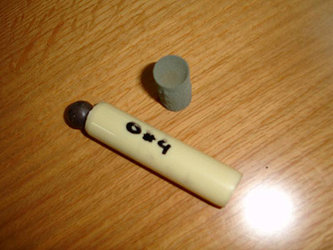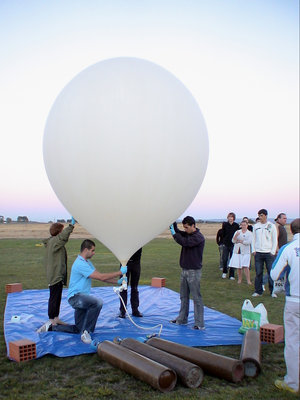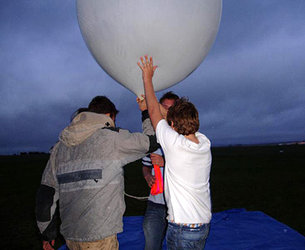The 2007 STRAPLEX student workshop
In September 2007, a series of flights involving helium balloons will take to the air over Portugal. On board the STRAtospheric PLatform EXperiment (STRAPLEX) balloons will be several experiments provided by students from various ESA member states.
Nine student teams from Belgium, Norway, Sweden, the UK, Portugal and Spain have been selected to develop their experiment proposals for these flights. In preparation for the balloon campaign, 21 high school and university students, together with their teachers or professors, attended a STRAPLEX workshop, held 25-26 June at ESA’s Technology and Research Centre (ESTEC) in Noordwijk, the Netherlands.
During the workshop, the students were given a tour of the satellite testing facilities and the International Space Station User Centre at ESTEC. After introductory talks describing the STRAPLEX programme and the technical details of the balloons and capsule, each team gave a presentation on its experiment proposal to experts from ESA and the University of Porto. In order to assist the teams in their efforts to refine and complete their experiments in the coming months, time was allocated for feedback and technical advice from scientists and engineers on the development and building of the experiments.
The experiments presented by the teams at the workshop were:
- Hydrogen brain cells (St-Olav High School, Stavanger, Norway) - Measuring the distribution of hydrogen through the atmosphere.
- Static (University of Porto, Portugal) - Electrostatic rotation control of a flying module.
- PSoC-TTSE (University Miguel Hernandez, Elchein, Spain) - Programmable system on chip: testing the technology in the space environment.
- Cupid's Modern Arrows (Rymdgymnasiet, Kiruna, Sweden) - Will you still love me after a trip to space?
- Northern fLight (Rymdgymnasiet, Kiruna, Sweden) - Astronaut = sick, depressed and tired?
- NVT (Rymdgymnasiet, Kiruna, Sweden - back-up team) - Near-space conditions exposure to…
- Team X (Flegg High School, Great Yarmouth, UK) - Bio-fuel cell characteristics & magnetic field measurement.
- Team Y (Flegg High School, Great Yarmouth, UK) - The effect of ozone and CO2 concentration on solar radiation levels in the atmosphere.

Also selected as a suitable flight experiment was “SP.ACE-GM-Counterteam”, a Geiger-Müller counter experiment put forward by a team from Sint-Pieterscollege Jette, Brussels, Belgium. Although they could not attend the workshop, the students will discuss their experiment in a teleconference with the ESA and Porto experts.
“The students were most enthusiastic and should benefit considerably from the workshop,” said Helen Page of ESA's Education Office. “We were very pleased with the range of experiments put forward for the STRAPLEX flights. However, the teams will have to work very hard to meet the deadlines for the balloon campaign in September.”
The 2007 STRAPLEX campaign
STRAPLEX offers students from ESA member states and co-operating states the opportunity to send educational experiments into the stratosphere, up to 30 km above the Earth. The programme is led by the University of Porto, Portugal, in collaboration with the Education Projects Unit of the European Space Agency. STRAPLEX is intended to give students practical hands-on experience of developing and flying experiments prior to them pursuing a career in space technology and science.
Since its debut in December 2005, STRAPLEX has completed three qualification flights and a successful operational flight with two student payloads.
The 2007 STRAPLEX Balloon Campaign has been scheduled for 17-23 September 2007. The timetable of activities related to this campaign is as follows:
- June – September: Building of the experiments.
- 17-23 September: STRAPLEX Balloon Campaign (launch of experiments).
- End November: Publication of final reports from student teams.

The ESA Education Office funds the cost of the capsules and launches, as well as travel and subsistence for the selected student teams who attended the workshop and will participate in the Campaign. Final reports from the student teams will be collected with a view to publication.
Representatives of the Faculty of Engineering of the University of Porto participated in the selection of experiments and the ESTEC workshop. The University is also responsible for manufacturing the capsules and their standard onboard equipment, as well as integration of the student experiments. The Porto team will arrange the recovery of the capsules, return the experimental packages to the student teams, and distribute all flight data and experimental data to the students and ESA, together with an analysis of the flight data. All launches and operations will be coordinated from Évora, Portugal.











